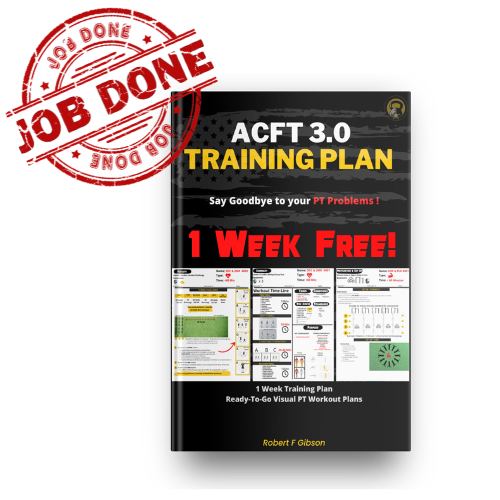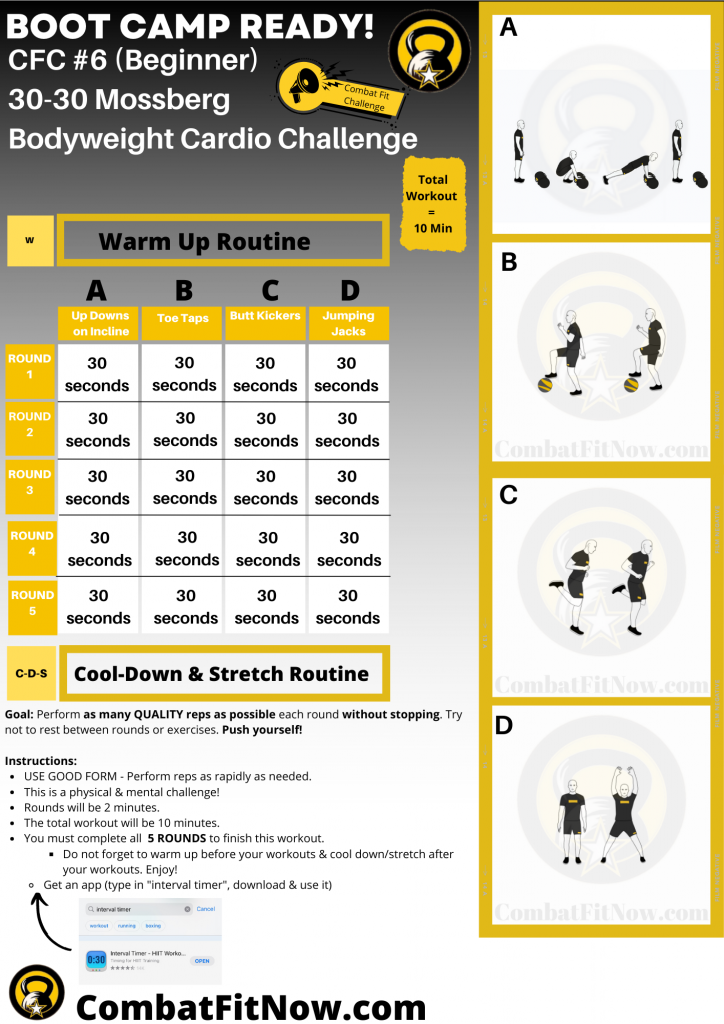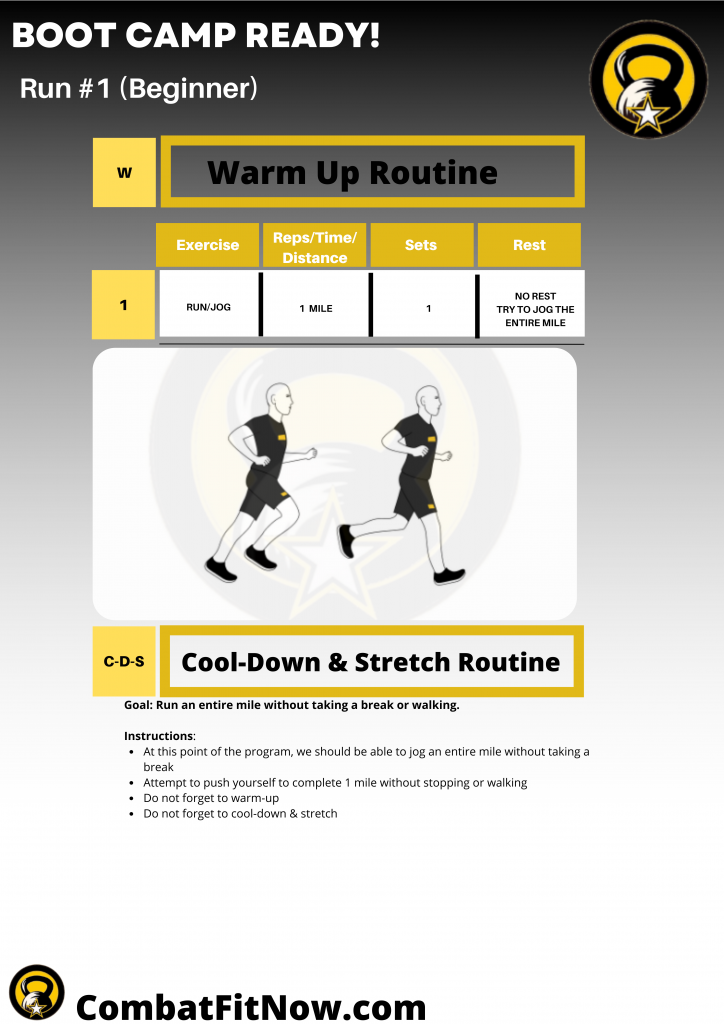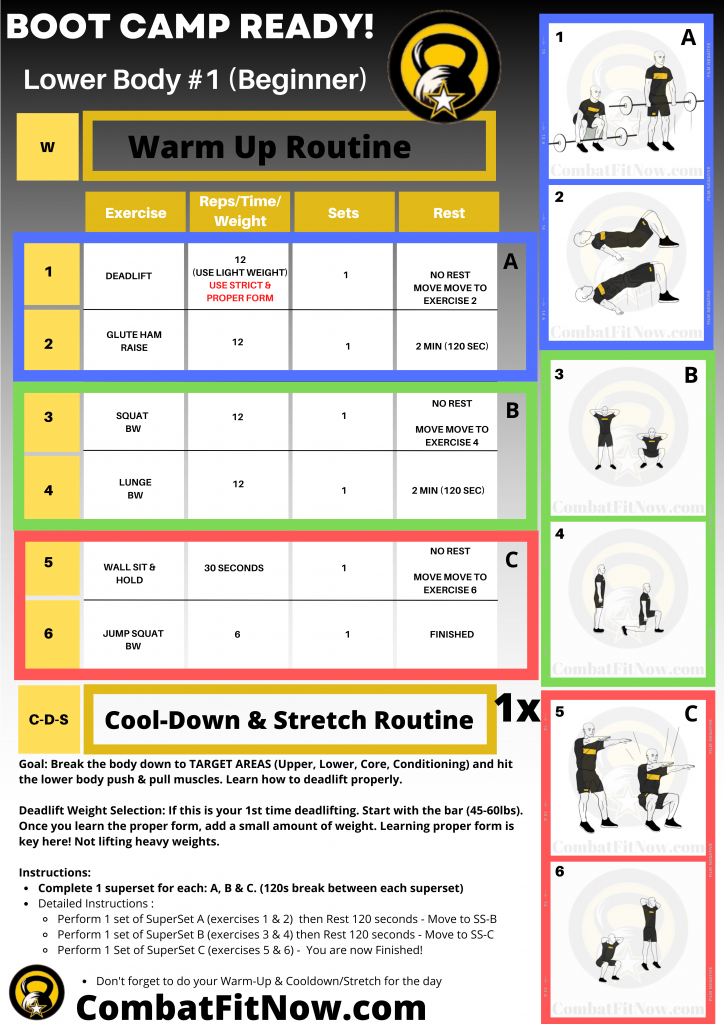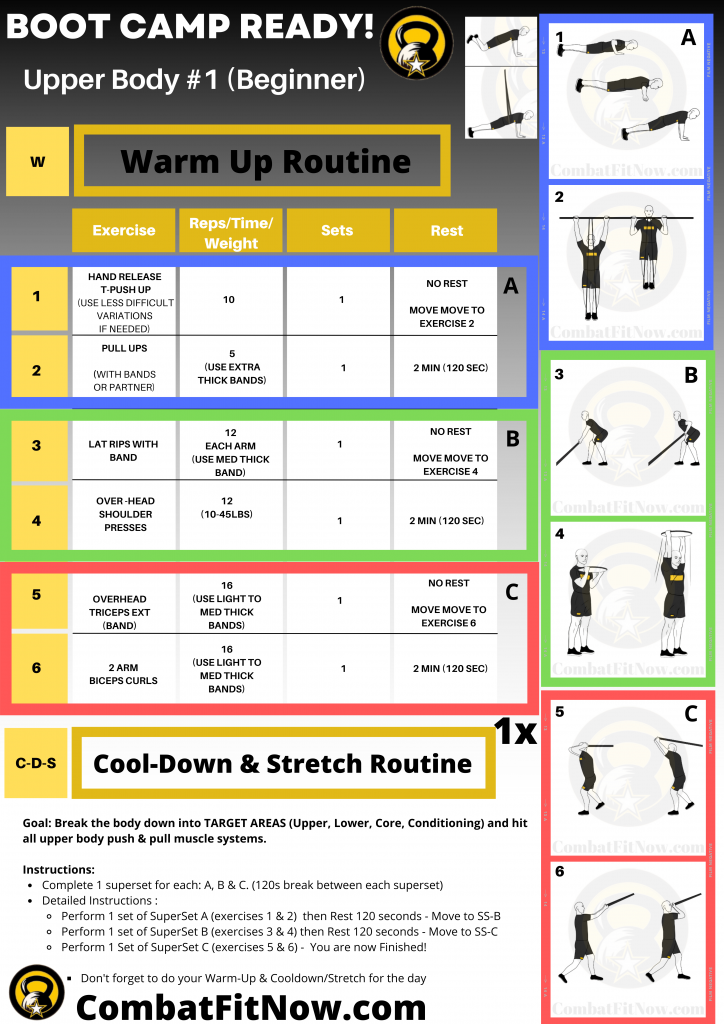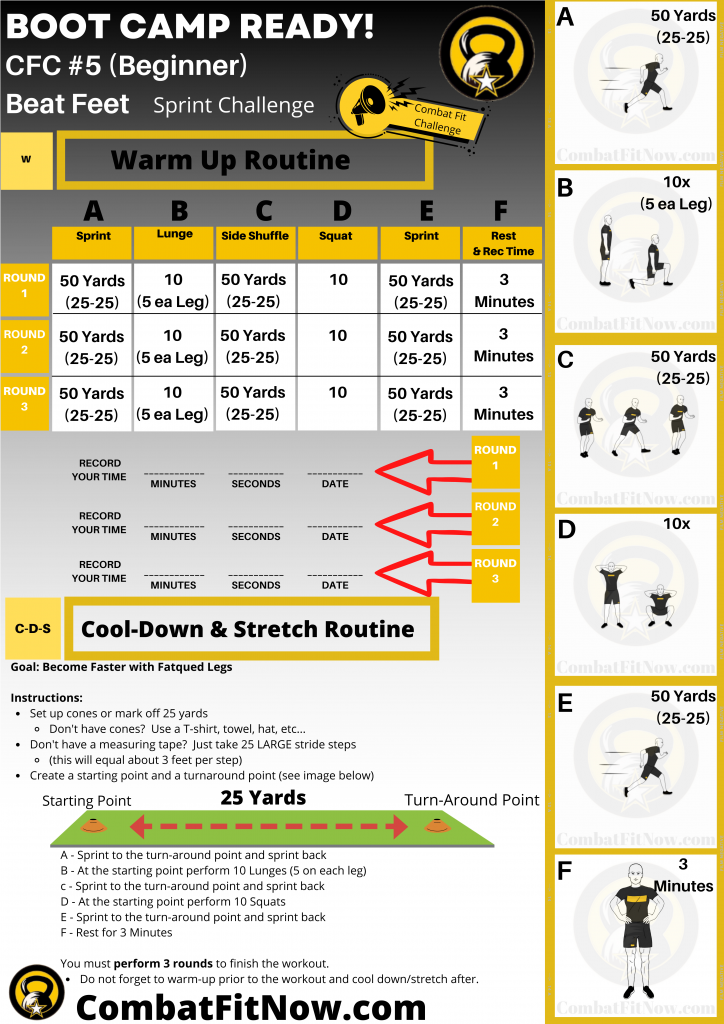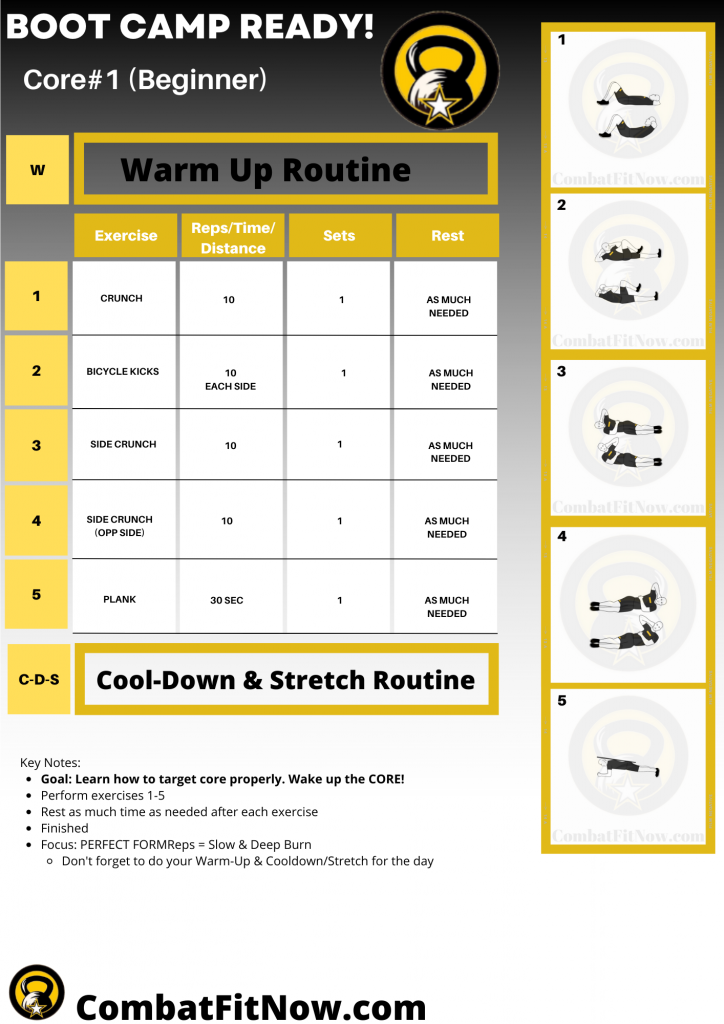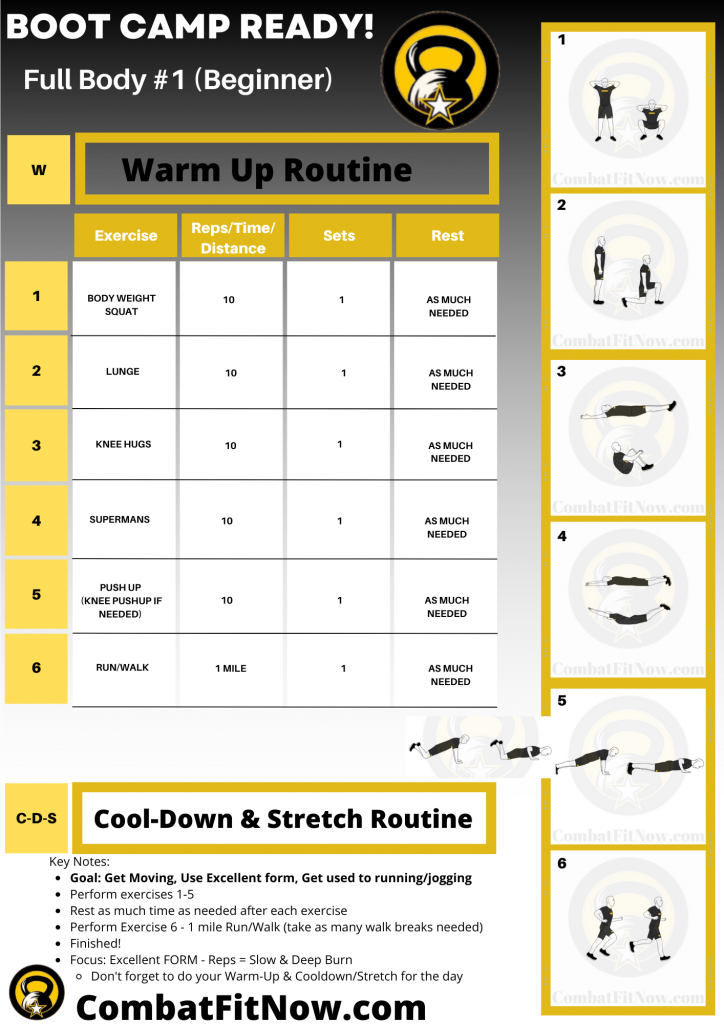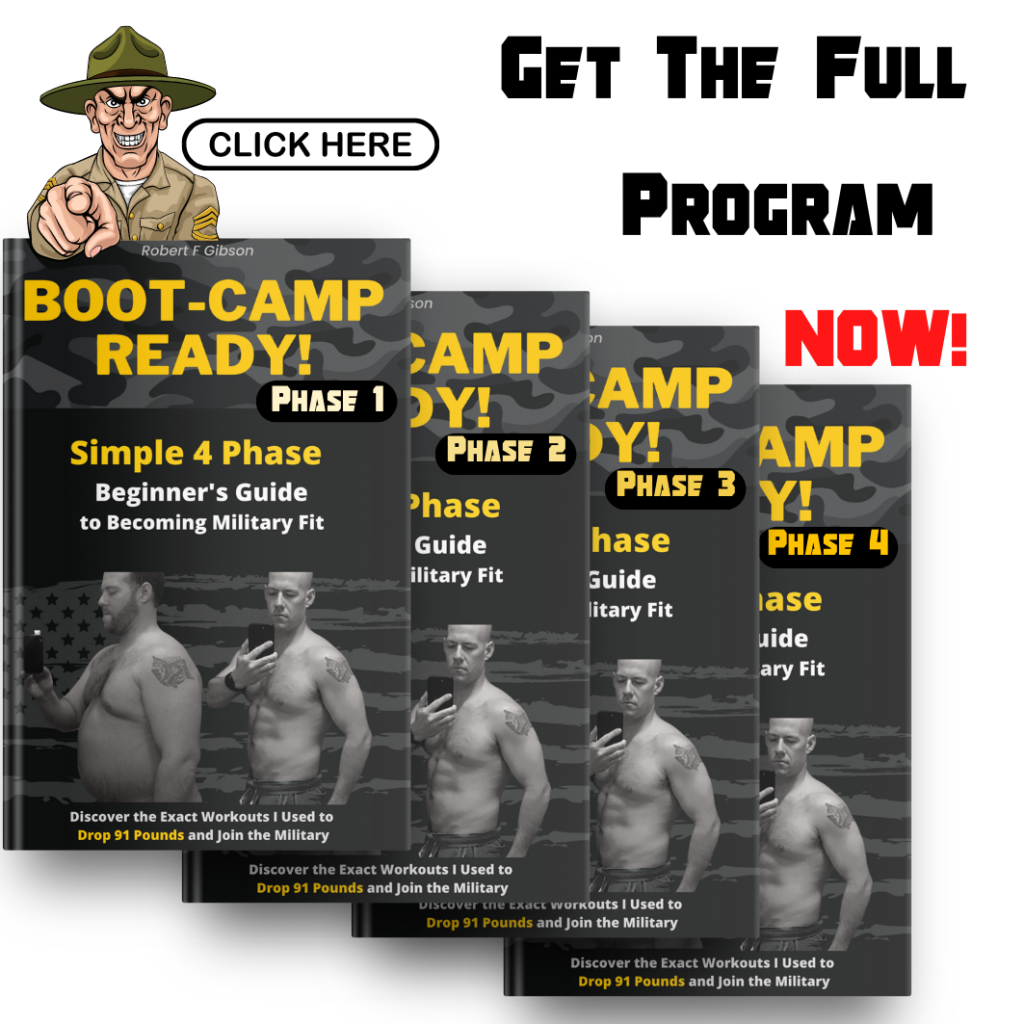Want the 10 best military workout plans and routines on the planet? Want a Military workout plan for any occasion or fitness desire?
No problem!
Table of Contents
- Choose Your Military Workout Fitness Level
- PT Workouts (BONUS)
- Military Boot Camp Workout Routines (BONUS)
- How to Prepare for the Military
- Military Exercises
Choose Your Military Workout Fitness Level
Military workouts are comprehensive and intense training regimens designed to enhance military personnel’s physical and mental capabilities. These workouts typically include cardiovascular conditioning, strength training, agility drills, and endurance challenges. The goal is to prepare individuals for the demanding physical tasks and unpredictable conditions they may encounter during service. Military workouts often prioritize functional fitness, focusing on movements that simulate real-world scenarios soldiers might face in the field. Additionally, teamwork and camaraderie are integral components, fostering a sense of cohesion among military units. These workouts are about building strength and endurance and instilling discipline, resilience, and the ability to perform under pressure, essential attributes for success in a military environment.
Military workouts for beginners aiming to join the military typically focus on building a foundation of strength, endurance, and agility while emphasizing proper form and technique. These workouts often include cardiovascular exercises, bodyweight movements, and functional strength training to prepare individuals for the physical demands of basic training. As recruits progress, the intensity and complexity of the exercises gradually increase to mirror the challenges they will face in military service.
On the other hand, advanced workouts for soldiers already in the military are designed to enhance specific skills required for their roles, such as tactical training, advanced marksmanship, and mission-specific conditioning. These workouts may involve more specialized equipment, incorporate military simulations, and emphasize teamwork and adaptability in high-stress situations. The progression from beginner to advanced military workouts reflects the evolving physical demands and skill requirements associated with military service.
Advanced Military Workout

28 Day Military Workout Challenge
28 Day Military Workout Routine Split


Summary of the 28 Day Military Workout Challenge
| Main Goal | Increase Military Fitness at an Advanced Level |
| Workout Type | ALL: Strength, Endurance, HIIT(Anaerobic), Core, Run(Aerobic), Mobility, Stretching |
| Training Level | Advanced |
| Program Duration | As long As Needed |
| Days per Week | 5 Days a Week |
| Time per Workout | 60 min |
| Equipment Needed | ALL MILITARY EQUIPMENT |
| Target Gender | Male & Female |
| Recommended Supplements | Whey Protein, Creatine |
| Author | Robert Gibson |
| Workout PDF |
Military Workout Plan PDF
FREE DOWNLOADS
Running Military Workout Plan PDF
#1
Military Workout: AGR#001
| Exercise | Distance | Resistance | Time |
| Run/Jog | 2.5 Miles | 65-70% Max Run | 16-22min |
Full Body Military Workouts
#2
Military Workout: MDL & SPT #001
| Exercise | Interval Time | Repetitions | Resistance | Rounds |
| Barbell Deadlift | 45s | 6-10 | Heavy | 4-5x |
| Rest | 45s | – | – | 4-5x |
| Shoulder Front Raise | 45s | 12-16 | Med to Heavy | 4-5x |
| Rest | 45s | – | – | 4-5x |
| Total Time | 3 Minutes | 12-15min |
| Exercise | Interval Time | Repetitions | Resistance | Rounds |
| KB Dead Up Right Row | 60s | 16-20 | Med to Light | 4x |
| Rest | 60s | – | – | 4x |
| Kettlebell Swings | 60s | 16-20 | Light | 4x |
| Rest | 60s | – | – | 4x |
| Total Time | 4 Minutes | 16 Min |
Military Bodyweight Workout Plan PDF
#3
Upper Body Military Workout
| Exercise | Interval Time | Repetitions | Resistance | Rounds |
| Weighted Hand Release Push Ups | 45s | 6-10 | Heavy | 4-5x |
| Rest | 45s | – | – | 4-5x |
| Pull Up | 45s | 6-10 | Heavy | 4-5x |
| Rest | 45s | – | – | 4-5x |
| Total Time | 3 Minutes | 12-15min |
| Exercise | Reps | Sets |
| Real V- Up | 10 | 2 |
| American Twists | 16 | 2 |
| Bicycle Kicks | 20 | 2 |
| Flutter Kicks | 20 | 2 |
| Plank | 90 sec | 2 |
| Rest | 120 seconds | – |
Conditioning Full Body Military Workout
#4
Conditioning Military Workout
| – | A | B | C | D | E | F |
| – | Sprint | Lunge | Side Shuffle | Squat | Sprint | REST |
| Round 1 | 50 Yards | 10 | 50 yards | 10 | 50 Yards | 3 Min |
| Round 2 | 50 Yards | 10 | 50 yards | 10 | 50 Yards | 3 Min |
| Round 3 | 50 Yards | 10 | 50 yards | 10 | 50 Yards | 3 Min |
| Exercise | Distance | Resistance | Time |
| Run | 1 Mile | 65-70% | 8-12 min |
Long Distance Run Military Workout Plan PDF
#5
Long Distance Run Military Workout
| Exercise | Distance | Resistance | Time |
| Run/Jog | 2.5 Miles | 65-70% | 20-30min |
FREE
Military Workout Program PDF
Get the Full Program Now
Military Workouts for Beginners


Military Workout Program


60 Day Military Workout Program for Beginners
Beginner Military workout program designed to get you off the couch and into Military shape.
In gearing up for a Military Workout Program spanning 60 days, it’s crucial to establish a consistent routine. Prioritize warming up and cooling down, focusing on incorporating stretches after each session. For beginners, kick off your fitness journey with full-body workouts and interspersed short-distance runs complemented by walk breaks.
As you progress, evolve your approach with a strategic workout split. We use workouts such as Upper Push-Pull, Lower Body and shoulders, and Core and Heart (emphasizing Conditioning and cardio). This progressive structure ensures a comprehensive and effective training regimen for optimal results over the designated 60-day period.
Military Workout Program for Beginners
Embarking on a fitness journey requires a fundamental workout regimen, especially for beginners aiming to enhance their physical condition, whether gearing up for military service or simply striving to boost overall fitness. The pivotal factor for an effective plan lies in commencing with manageable exercises and progressively advancing to more demanding workouts as your body acclimates. Initiating high-intensity workouts prematurely may result in physical and mental strain, leading to potential injuries and burnout. Explore a well-structured Military Workout Program for Beginners to kickstart your fitness goals wisely.


Don’t Try to be a Hero on Your First Day
Beginners preparing for military fitness should start their training gradually and focus on building a solid foundation before engaging in intense workouts. To develop overall fitness, it’s crucial to begin with a balanced mix of cardiovascular exercises, strength training, and flexibility work. Starting slow allows the body to adapt and reduces the risk of injuries, ensuring a sustainable and progressive fitness journey. As beginners become more comfortable with their routine, they can gradually increase their workouts’ intensity, duration, and complexity. Incorporating exercises that mimic military fitness requirements, such as running, bodyweight exercises, and endurance training, will help individuals develop the specific skills needed for military service. Additionally, paying attention to proper nutrition, hydration, and recovery is essential for optimizing performance and minimizing the risk of burnout or overtraining.
Beginner Military Workout Program – Schedule
Beginner Military Workout SUMMARY
| Main Goal | Prepare for Basic Military Training – Beginner Military Workout Routine |
| Workout Type | ALL: Strength, Endurance, HIIT(Anaerobic), Core, Run(Aerobic), Mobility, Stretching |
| Training Level | Beginner/Novice |
| Program Duration | 60 Days or As long as needed. |
| Days per Week | 7 Days of Being Active/Working Out |
| Time per Workout | 15 – 60 min |
| Equipment Needed | MINIMUM EQUIPMENT NEEDED: 1. Bands (Multi-Level Thickness) 2. Barbell 3. Olympic Weight Set 4. Pull-Up Bar & Adjustable Squat/Bench Rack 5. Dumbbells or Kettlebells |
| Target Gender | Male & Female |
| Recommended Supplements | Beginner Supplement Stack |
| Author | Robert Gibson |
| Workout PDF | Download (60 Day Preview) |
Beginner Military Workout 4-Phase Plan
Goals & Objectives:
- Get used to working out every day.
- Perform all workouts at a BEGINNER LEVEL and advance ONLY when YOU ARE READY.
- Perform a warm-up and stretch every day.
- Be Boot-Camp Ready!
Phase 1 – Week 1&2 – Get Your A** off the Couch & Start Moving
Phase 2 – Week 3&4 – Now Your Moving!
Phase 3 – Week 5&6 – You are Starting to Look Like a Soldier
Phase 4 – Week 7-9 – You’ll Be Ready
Phase 5 – Week 9+ – Rising Above Your Competition – Time for a NEW & Advanced Plan
Military Workout Plan for Beginners
Workouts to prepare for basic training are crucial for anyone looking to join the military. Basic training can be physically demanding, so it’s important to prepare your body and mind for the challenges ahead. Many resources are available to help you get started, and one great option is to find free PDF workout plans below. These plans typically include a mix of cardio, strength training, and flexibility exercises that will help you build the endurance, strength, and flexibility you’ll need for basic training.
Free PDFs for You:
Military Boot Camp Workout
Military boot camp workouts prepare individuals physically and mentally for the challenges they will face during Army Basic Training (also known as Basic Combat Training or BCT). These workouts focus on building strength, endurance, agility, and teamwork—all essential components for success in military training. Here are some key aspects of how military boot camp workouts prepare individuals for Army Basic Training:
Physical Conditioning:
- Cardiovascular Endurance: Military boot camp workouts typically include aerobic exercises such as running, swimming, and high-intensity interval training (HIIT). HIIT helps participants build the cardiovascular endurance needed for activities like long marches and obstacle courses in Basic Training.
- Strength Training: Basic Training involves various physical activities that require strength, such as carrying heavy gear, lifting equipment, and navigating challenging terrain. Boot camp workouts include strength training exercises like weightlifting, bodyweight exercises, and circuit training to build overall strength.
- Flexibility and Mobility: Flexibility is crucial for performing various military tasks and preventing injuries. Boot camp workouts often incorporate stretching and mobility exercises to enhance flexibility and range of motion.
Teamwork and Camaraderie:
- Military operations heavily depend on teamwork and cooperation. Boot camp workouts are structured to foster collaboration by including partner exercises, group activities, and team challenges. Helping individuals develop trust and communication skills is vital during Basic Training and beyond.
- The shared experience of pushing through physically demanding workouts builds camaraderie among participants. This sense of unity is essential for military cohesion and effectiveness.
Discipline and Mental Toughness:
- Boot camp workouts are intentionally demanding to instill discipline and mental toughness. Soldiers need to overcome physical and mental challenges during Basic Training, and the workouts serve as a precursor to the mental resilience required in the military.
- The structured and rigorous nature of boot camp workouts helps individuals develop a strong work ethic, self-discipline, and the ability to push through discomfort—an essential mindset for success in Army Basic Training.
Skill Development:
- Basic training involves learning various military skills, such as marksmanship, first aid, and navigation. While boot camp workouts may not directly teach these skills, but they contribute to overall physical fitness, a foundation for mastering specific tasks during Basic Training.
Introduction to Military Culture:
- Military boot camp workouts often incorporate elements of military culture, including adherence to structure, following orders, and learning basic military terminology. This introduction helps participants become familiar with the army environment before entering Basic Training.
In summary, military boot camp workouts serve as a foundational step in preparing individuals for the physical and mental challenges of Army Basic Training. The exercises focus on building strength, endurance, teamwork, discipline, and mental toughness—all essential attributes for success in the military.
Conditioning Military Boot Camp Workout
#6
| Round | Up Downs on Incline | Toe Taps | Butt Kickers | Jumping Jacks |
| 1 | 30 Seconds | 30 Seconds | 30 Seconds | 30 Seconds |
| 2 | 30 Seconds | 30 Seconds | 30 Seconds | 30 Seconds |
| 3 | 30 Seconds | 30 Seconds | 30 Seconds | 30 Seconds |
| 4 | 30 Seconds | 30 Seconds | 30 Seconds | 30 Seconds |
| 5 | 30 Seconds | 30 Seconds | 30 Seconds | 30 Seconds |
Cardio Military Boot Camp Workout
#7
| Exercise | Distance | Sets | Rest | |
| 1 | Run/Walk | 1 Mile | 1 | Jog Entire Mile (walk only when needed) |
Lower Body Military Boot Camp Workout
#8
| Exercise | Reps | Sets | Rest | |
| 1 | Deadlift | 12 | 1 | 0 |
| 2 | Glute Ham Raise | 12 | 1 | 2 Min |
| 3 | Squat | 12 | 1 | 0 |
| 4 | Lunge | 12 | 1 | 2 Min |
| 5 | Wall Sit | 30 Sec | 1 | 0 |
| 6 | Jump Squat | 16 | 1 | – |
Upperbody Military Boot Camp Workout
#9
| Exercise | Reps | Sets | Rest | |
| 1 | Hand Release Push Up | 10 | 1 | 0 |
| 2 | Assisted Pull Ups | 5 | 1 | 2 Min |
| 3 | Lat Rips | 12 | 1 | 0 |
| 4 | OH Houlder Press | 12 | 1 | 2 Min |
| 5 | OH Triceps Ext | 16 | 1 | 0 |
| 6 | 2 Arm Biceps Curls | 16 | 1 | – |
HIIT Military Boot Camp Workout
#10
| – | A | B | C | D | E | F |
| – | Sprint | Lunge | Side Shuffle | Squat | Sprint | REST |
| Round 1 | 50 Yards | 10 | 50 yards | 10 | 50 Yards | 3 Min |
| Round 2 | 50 Yards | 10 | 50 yards | 10 | 50 Yards | 3 Min |
| Round 3 | 50 Yards | 10 | 50 yards | 10 | 50 Yards | 3 Min |
Military Ab Workout
Bonus Workout #1
| Exercise | Reps | Sets | Rest |
| Crunch | 10 | 1 | As Much Needed |
| Bicycle Kicks | 10 (each leg) | 1 | As Much Needed |
| Side Crunch | 10 | 1 | As Much Needed |
| Side Crunch | 10 | 1 | As Much Needed |
| Plank | 30 Sec | 1 | As Much Needed |
Full Body Military Boot Camp Workout
Bonus Workout #2
| Exercise | Reps | Sets | Rest |
| Bodyweight Squat | 10 | 1 | As Much Needed |
| Lunge | 10 | 1 | As Much Needed |
| Knee Hugs | 10 | 1 | As Much Needed |
| Supermans | 10 | 1 | As Much Needed |
| Push Ups | 10 | 1 | As Much Needed |
| Run/Walk | 1 mile | 1 | As Much Needed |
PT Workouts


1. Bonus PT Workout


2. Bonus PT Workout


3. Bonus PT Workout


4. Bonus PT Workout


5. Bonus PT Workout


Military Boot Camp Workout Routines
Bringing you the best Workouts to Prepare for Basic Training. The workouts below were constructed not to challenge you physically but mentally as well. We will use all muscle and energy systems when performing these workouts. Once you can perform these workouts, you will be ready for the military.


Warning – Some of these workouts may be difficult for you as a beginner. Videos and PDFs are for information purposes only. Get your medical professional’s approval before starting any workout routine.
Workout Summary – Boot Camp Workout Routine
| Program | Boot-Camp Ready! |
| Main Goal | Beginner Workout / Prepare for Basic Training |
| Workout Type | Conditioning Challenges |
| Training Level | Beginner/Novice |
| Program Duration | As long as needed. |
| Time per Workout | <30 min |
| Equipment Needed | NA |
| Target Gender | Male & Female |
| Recommended Supplements | Whey Protein & Multi-Vitamin |
| Author | Robert Gibson |
FREE Video & PDF Boot Camp Workouts
1. Boot Camp Workout Routine
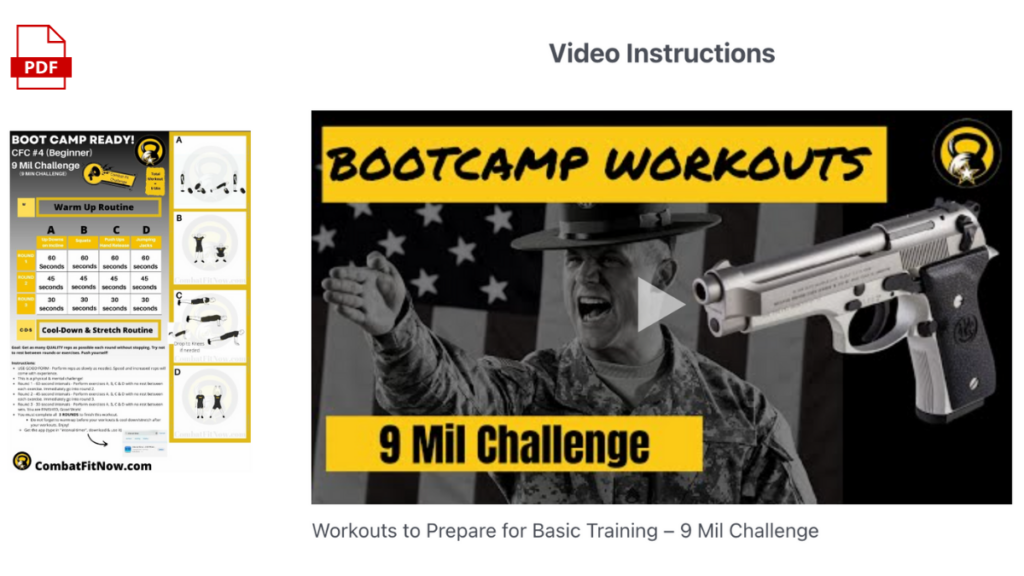

2. Boot Camp Workout Routine
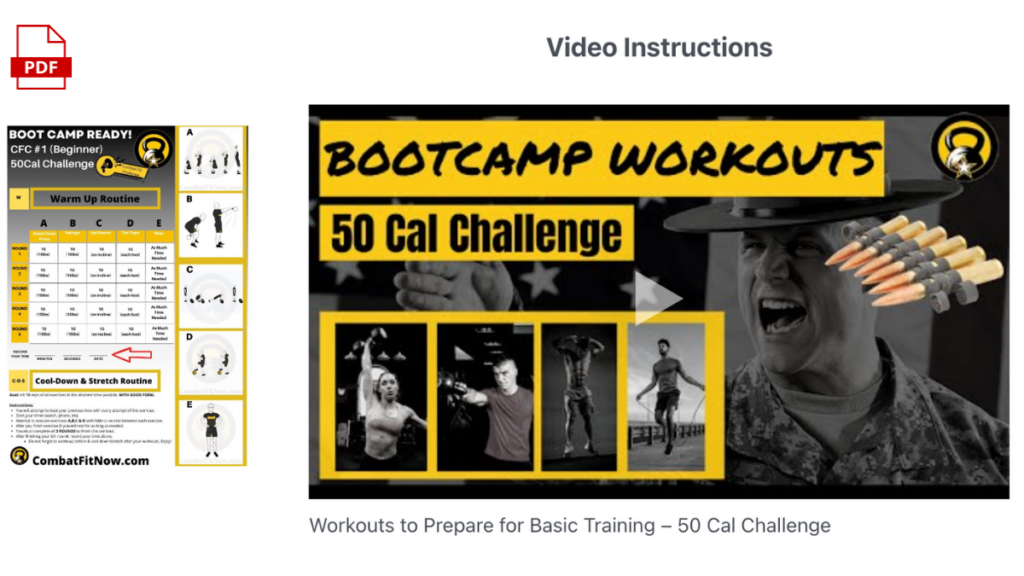

3. Boot Camp Workout Routine
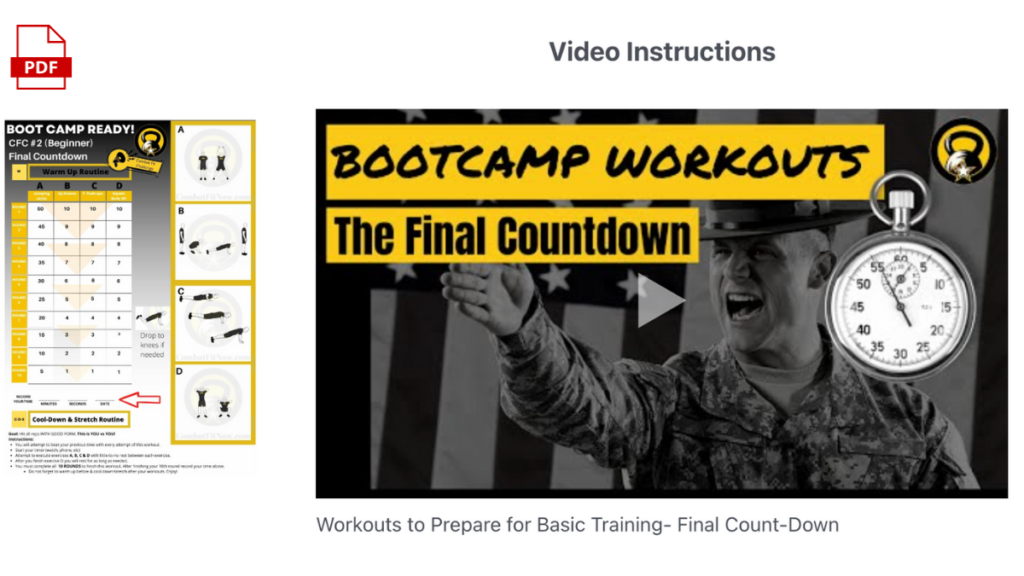

4. Boot Camp Workout Routine
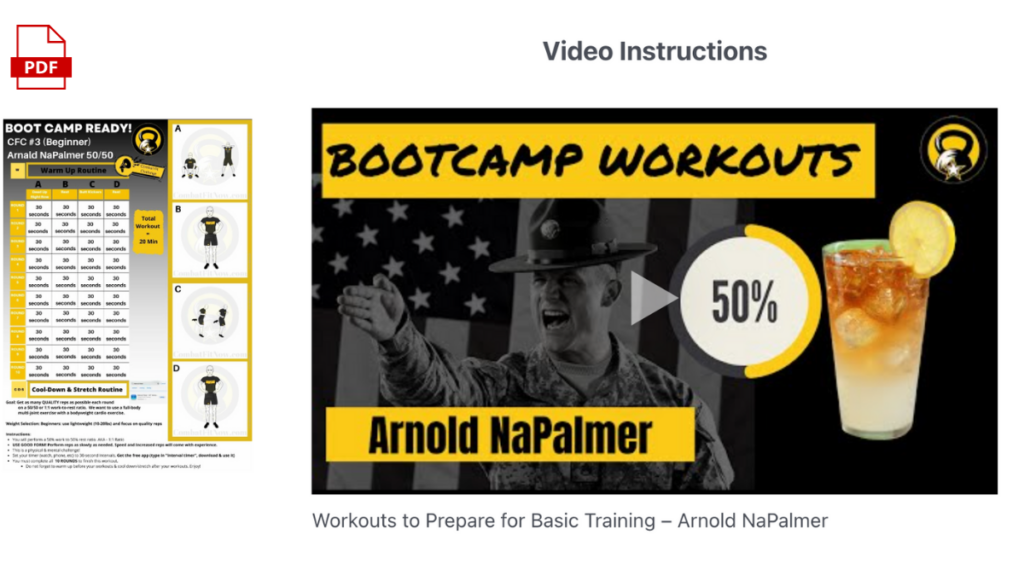

5. Boot Camp Workout Routine
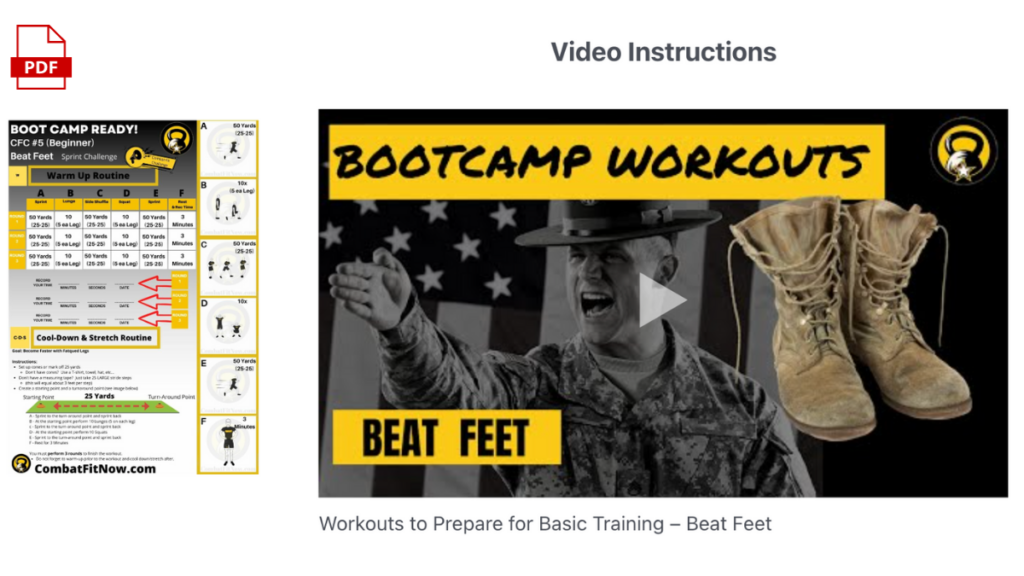

6. Boot Camp Workout Routine
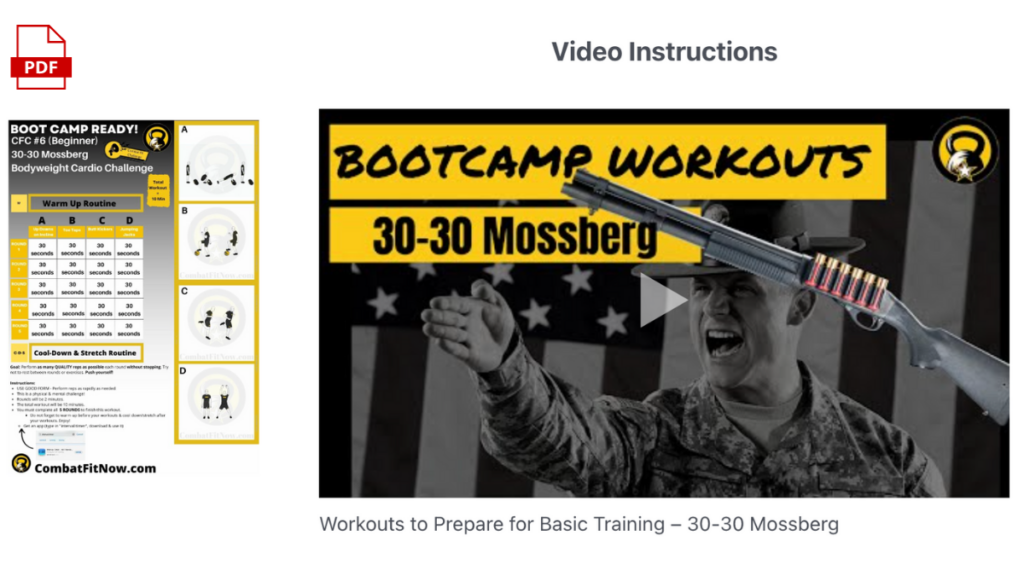

7. Boot Camp Workout Routine
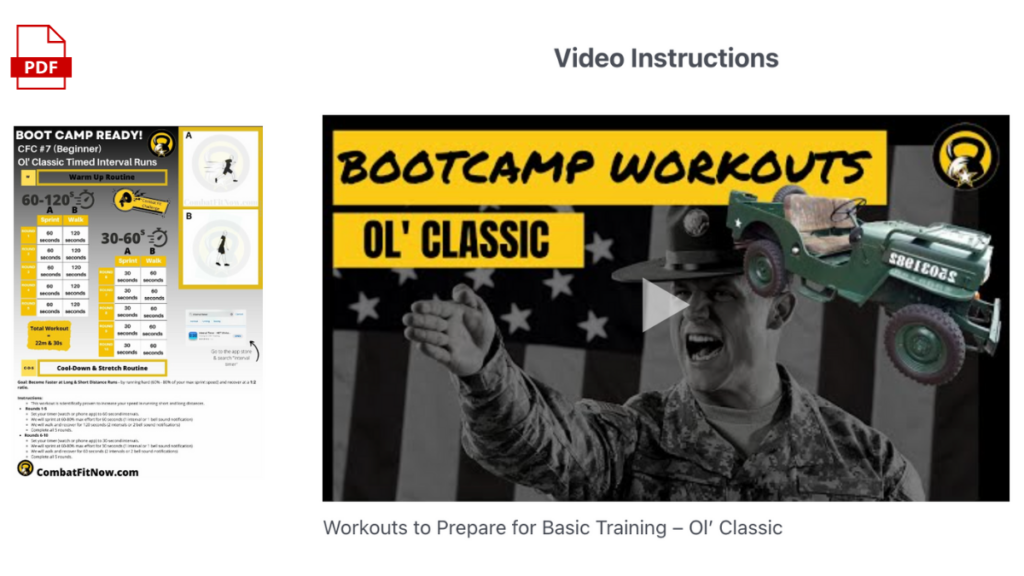

How to Prepare for the Military
Preparing for military service requires careful attention to three crucial aspects:


- Ensuring optimal health is paramount. A comprehensive visit to the doctor is essential to confirm that there are no severe health issues that may hinder performance or eligibility. This step is crucial as military training demands physical and mental resilience.
- Rigorous physical preparation is indispensable. Military training involves demanding physical activities; candidates must be physically fit to meet the challenges. Regular exercise, strength training, and cardiovascular conditioning are essential to this preparation.
- Mental preparedness is equally vital.
Military service often requires individuals to confront stressful and challenging situations. Developing mental resilience through strategic thinking, discipline, and stress management techniques is crucial for success in the military. Combining these three elements—health, physical fitness, and mental readiness—creates a solid foundation for those aspiring to serve in the military.
Military Exercises
Selecting the right military exercises enhances military fitness and overall preparedness. Military exercises are designed to simulate real-world scenarios, test operational capabilities, and improve armed forces’ physical and mental readiness. Here are several reasons why choosing the right exercises is essential:


Fit to Fight
- Realism and Relevance: Exercises should mimic the conditions and challenges that military personnel may face in actual combat or other operational situations. Realistic scenarios help trainees develop practical skills and adaptability.
- Specific Training Objectives: Different exercises focus on specific aspects of military fitness, such as endurance, strength, agility, marksmanship, and teamwork. The right mix of exercises should align with the overall training objectives and the specific needs of the military unit.
- Comprehensive Physical Fitness: Military exercises should encompass a variety of physical activities to ensure a comprehensive approach to fitness. Including aerobic conditioning, strength training, flexibility exercises, and tactical skills training.
Team Building & Adatibiliy
- Team Building and Cohesion: The right exercises facilitate teamwork and foster unit cohesion. Military operations often require coordinated efforts among team members, so exercises should encourage communication, trust, and cooperation.
- Adaptability and Versatility: Military forces must be adaptable to various situations and environments. Exercises should expose personnel to different terrains, weather conditions, and scenarios to enhance their ability to handle unexpected challenges.
- Equipment Familiarization: If specific equipment or technology is integral to military operations, exercises should provide opportunities for personnel to familiarize themselves with and master such equipment.
- Mental Resilience and Decision-Making: Military exercises should challenge participants mentally, simulating the stress and decision-making requirements of actual combat, helping to develop mental resilience, problem-solving skills, and the ability to make sound decisions under pressure.
Evals & Risk Managment
- Evaluation and After-Action Review: After each exercise, a thorough evaluation and after-action review (AAR) are essential. This allows military leaders to assess performance, identify strengths and weaknesses, and make improvements for future training sessions.
- Risk Management: The selection of exercises should consider safety and risk management. While training should be challenging, it should not unnecessarily endanger participants. Careful planning and supervision are essential to minimize risks.
- Resource Efficiency: Choosing exercises that make the most efficient use of resources, including time, personnel, and equipment, is critical. This ensures that training programs are cost-effective while still providing valuable experiences.
In summary, the correct military exercises enhance military fitness by providing realistic, relevant, and comprehensive training experiences. Tailoring exercises to specific objectives, fostering teamwork, and promoting adaptability contribute to the overall readiness of military forces. Regular evaluation and adjustments to training programs are essential for continuous improvement.
For a Full List of Military Exercises, Click Below
Military Workout Plans Overview
A Military workout plan (or split) refers to the way in which an individual divides their exercise routine into specific days or sessions for different muscle groups or body parts. It’s a way to organize your workout routine to target specific muscle groups effectively. For example, a common workout split is the “push-pull” split, where one day is dedicated to exercises that target the chest, shoulders, and triceps (push muscles) and another day is dedicated to exercises that target the back, biceps, and legs (pull muscles). Other splits include full body, upper body/lower body split, or body part splits like legs, chest and back, shoulder and arms. Each workout split has its own advantages and disadvantages, it’s important to choose one that aligns with your fitness goals and schedule.
When you get to this level, you will need to do a more advanced workout routine.
Military Workout Info
A military workout typically refers to a type of physical training that is designed to improve strength, endurance, and overall fitness in order to prepare individuals for military service. These workouts often include a combination of cardio, strength training, and functional exercises that are intended to simulate the physical demands of military activities such as marching, carrying heavy equipment, and performing other physically demanding tasks. Military workouts often focus on full-body conditioning and may include exercises such as running, calisthenics, weightlifting, and obstacle course training.
Military Training Workout Challenges
A single workout challenge is a fitness program or competition that is focused on a specific exercise or set of exercises, and is typically completed in one session or over a short period of time, such as a day or a week. These challenges are usually focused on a specific body part or fitness goal, such as a Plank Challenge, Push-up Challenge, or a Squat Challenge.
A single workout challenge is designed to test the individual’s physical strength, endurance, and overall fitness level, and to help them achieve specific fitness goals. These challenges can be completed individually, but some people find it more motivating to do them with friends, family or in a group setting. The format of a single workout challenge can vary, but typically it involves completing a set number of repetitions or holding a specific exercise for a set amount of time. The goal is to progress over the course of the challenge by increasing the number of reps, weight, or duration of the exercise.
Military Bodyweight Workout Plan
Bodyweight or Calisthenic workout plans are the true OG when it comes to Military workouts. To be honest, if you want to get into great shape, all you need is your body’s resistance to get a quality workout. In today’s Military, we use equipment, but a good number of our workouts are still calisthenics. I always ensure I put a nice mix of calisthenics in every workout plan.
A military bodyweight workout is one of the oldest and best ways to get into shape for a number of reasons. First and foremost, bodyweight workouts do not require any weights or machines, making them accessible to anyone, anywhere. All you need is your own body and a bit of space to move around. This makes them ideal for those who don’t have access to a gym or expensive equipment.
Cardio & Running Military Workout
Good ol’ Cardio workouts. Everyone talks about biceps and chest workouts. Did you know your heart is a muscle too? We must work our hearts for long periods. What are the health benefits that come with training the number one muscle in your body?
healthline.c
- Improves cardiovascular health. …
- Lowers blood pressure. …
- Helps regulate blood sugar. …
- Reduces asthma symptoms. …
- Reduces chronic pain. …
- Regulates weight. …
- Aids sleep. …
- Strengthens immune system.
- and more!
Military HIIT Workout Plan (High Intensity Interval Training)
HIIT BABY! A lot of people love HIIT workouts. Why? Well, because they are short and extremely effective. HIIT Workouts are designed to make you work hard for a short period; then they allow rest for a short period, so your heart rate returns to a slower pace, and you are ready to go all out again. There are wide varieties of HIIT workouts I could talk about for days. I love them for everything, Strength Training, Fat Loss, Conditioning, you name it, there is a HIIT workout for everything, not to mention they are extremely time efficient. My favorite workouts are HIIT.
Military Workout: Bodyweight Workout Plan
Calisthenic To be honest, if you want to get into great shape, all you need is your body’s resistance to get a quality workout. In today’s Military, we use equipment, but a good number of our workouts are still calisthenics. I always ensure I put a nice mix of calisthenics in every workout plan.
Bodyweight workouts are also highly effective for building strength and endurance. Exercises like push-ups, squats, lunges, and burpees all use your own body weight as resistance, which can be plenty challenging on its own. By continually adding reps or increasing the difficulty of the exercises, you can progressively overload your muscles and see real strength gains.
In addition to building strength, bodyweight workouts are also great for conditioning and improving cardiovascular fitness. Many bodyweight exercises are high-intensity and involve multiple muscle groups, which means they can get your heart rate up and help you build endurance.
Overall, a military bodyweight workout is a tried and true way to get into shape, build strength and endurance, and improve your overall fitness level. It’s simple, effective, and requires no special equipment, making it an excellent choice for anyone looking to get fit. So, give it a try and see the results for yourself!
Military Calisthenics Workout
Military calisthenics, also known as military conditioning, is a type of exercise program that uses bodyweight exercises to improve strength, endurance, and overall physical fitness. It is often used by military personnel to prepare for the physical demands of military service, but it is also popular among civilians looking to get in shape.
Military calisthenics typically includes a variety of exercises such as push-ups, sit-ups, squats, lunges, and burpees, performed in high-intensity intervals or circuit training format. These exercises are designed to work multiple muscle groups at once, improving strength and endurance while also getting the heart rate up for cardiovascular benefits.
Military calisthenics programs often include additional exercises or challenges such as carrying heavy objects, crawling, climbing, and sprinting, to further increase the intensity and overall difficulty of the workout.
Overall, military calisthenics is a challenging and effective way to improve physical fitness, with a focus on functional movement and full-body conditioning.
Full Body Military Workout
Full body military workouts are great for hitting every muscle in the body because they typically involve a variety of exercises that work multiple muscle groups at the same time. This is known as compound exercises, and they are highly effective for building strength, improving functional movement, and increasing overall muscle mass.
Full Body Muscle Workout (Beg/Novice Level) PDF
For example, exercises like push-ups, squats, and lunges all work multiple muscle groups at the same time, including the chest, shoulders, back, legs, and core. This means that you are able to effectively train all of the major muscle groups in your body with just a few exercises.
Hitting every muscle in the body during a workout has a number of benefits. First, it helps to create an overall balanced and well-rounded physique, rather than just focusing on one or two specific muscle groups. It also helps to improve functional movement and everyday activities, as you are training your muscles to work together rather than in isolation.
In addition, training every muscle in the body can also help to increase the number of calories you burn, even after your workout is over. When you put your muscles through a challenging workout, they will need to repair and rebuild themselves, which requires energy in the form of calories. This process, known as muscle protein synthesis, can continue for up to 48 hours after your workout, which can help to increase your overall calorie expenditure.
Overall, full body military workouts are an effective way to train every muscle in the body, improve functional movement, and increase calorie expenditure. They can be a challenging and rewarding way to get in shape and improve overall physical fitness.
Full Body Conditioning Workout (Beg/Novice Level) PDF
When you start to gain some workout experience, full body workouts are great for conditioning. You can start to implement more challenging exercises mixed with weights. This is how you burn some serious calories and shred fat off your body.
Military Legs & Shoulders Workout
The mixture of Legs & Shoulders is a deadly combination! You will work your legs very hard; then, give them some rest as you torture your shoulder muscles. This perfect combo works great because getting maximum rest for your legs allows you to train your legs heavier and harder. Why waste valuable rest periods when you could be hitting those shoulders?
Military Legs Workout
A leg workout is a type of physical exercise that targets the muscles in the legs, such as the quadriceps, hamstrings, glutes, and calves. The main goal of a leg workout is to build muscle, increase strength and endurance, and improve overall fitness in the lower body. A typical leg workout may include exercises such as squats, lunges, deadlifts, leg press, and leg extensions. These exercises work multiple muscle groups in the legs, and are often considered compound exercises, meaning they work multiple joints and muscle groups at the same time.
Some leg workouts also include isolation exercises like calf raises, leg curls, and leg extensions that focus on specific muscles in the legs, these exercises can be used to target muscle imbalances and to improve overall leg development.
It’s important to note that a leg workout should always include a good warm-up and cool-down, to prevent injury and to improve flexibility. It’s also important to use proper form and to gradually increase the weight or resistance over time to avoid injury and to promote muscle growth.
Military Upper Body Push-Pull Workout
You must follow a push-pull recipe of training the upper body to be in the optimum shape. Your chest and triceps will only be as strong as your back and biceps. Never forget that unless you want some serious shoulder injuries and a weak upper body appearance.
Military Ab Workout
Military ab workouts are some of the best for several reasons. First and foremost, they are designed to hit all four of the core muscles: the abdominals, obliques, low back, and transverse abdominis. By targeting all of these muscle groups, you are able to create a strong and well-rounded core, which is essential for overall athletic ability and injury prevention.
In addition to targeting the core muscles, military ab workouts are also typically high-intensity and involve exercises that work multiple muscle groups at once. This means that you are not only building strength in your abs, but also improving your overall functional movement and full-body conditioning.
By training all four of the core muscles, you can increase your total athletic ability and prevent injury. A strong core is essential for activities like running, jumping, and lifting, as it helps to stabilize the body and transfer power from the lower body to the upper body. In addition, a strong core can help to protect against common injuries like back pain and muscle strains.
Finally, military ab workouts are also an effective way to get the best abs possible. While no amount of exercise can spot-reduce fat, building strength in the abs can help to create a lean and defined midsection when combined with a healthy diet.
Military Ab Workout Summary
Overall, military ab workouts are a great choice for anyone looking to build a strong, well-rounded core, improve athletic ability and injury prevention, and get the best abs possible.
If you have never worked out before, it is important to start slowly and gradually build up your strength and endurance. Trying to do too much too soon can lead to injury and burnout. Instead, start with basic exercises like walking or jogging, and gradually introduce more challenging workouts on a weekly basis. This can help you build a strong foundation of fitness and prepare your body for the demands of boot camp.
It is also important to focus on a variety of different exercises, rather than just one or two, in order to train all of the major muscle groups and improve overall functional movement. This can include exercises like push-ups, squats, lunges, and burpees, as well as running, swimming, and other cardio activities.
While training for boot camp can be challenging, it is also an incredibly rewarding experience. Passing boot camp is a significant accomplishment, and it can also lead to a nice pay increase in the army, with promotions to ranks such as E-1 to E-4.
Overall, training for boot camp requires dedication and hard work, but with the right mindset and a gradual, consistent approach, it is possible to succeed and achieve your goals.
In the United States Army, an E-1 is a private, while an E-4 is a Specialist. You can start earning around $2,000 a month, free healthcare, and a free place to live. It’s safe to say a quality workout program going into boot camp will pay for itself with high returns.
Military Buddy Workout
(Also Known As PT)
A military buddy workout is a type of workout that is done with more than one person, although it can also be done by oneself. Buddy workouts can be a fun and effective way to stay motivated and on track with your fitness goals.
There are a number of benefits to doing buddy workouts. For one, having a workout partner can provide motivation and accountability, as you are more likely to show up and give your best effort when you have someone else counting on you. Working out with a friend or group can also make the experience more enjoyable, as you can chat, joke around, and push each other to perform your best.
Buddy workouts can also be a great way to stay on track with your fitness goals. By scheduling regular workout sessions with a partner, you are more likely to stick to your routine and avoid skipping workouts. Additionally, working out with a partner can provide an opportunity for friendly competition, which can help to increase motivation and keep things interesting.
An army PT (Physical Training) workout is essentially the same thing as a buddy workout, but it is typically led by a military instructor or drill sergeant and is focused on preparing soldiers for the physical demands of military service. PT workouts may include a variety of exercises such as running, calisthenics, and other functional movements, and are often done in a group setting to build teamwork and camaraderie.
PT Military Buddy Workout
Overall, buddy workouts (including PT workouts) can be an effective and enjoyable way to stay motivated, stay on track with your fitness goals, and improve overall physical fitness.
Military at home workouts are some of the best for a number of reasons. Here are a few:
- Cost: One of the main benefits of military at home workouts is that they are typically less expensive than gym memberships or personal training sessions. All you need is a little bit of space, your own body, and minimum home equipment. Which means you can save money on expensive monthly gym fees.
- Results: Military at home workouts can be just as effective as gym workouts for building muscle and losing fat. Bodyweight exercises like push-ups, squats, and lunges are highly effective for increasing strength and muscle mass, and can be done at home with minimal equipment. Additionally, high-intensity interval training (HIIT) workouts can be done at home to boost metabolism and burn fat.
- Time: Military at home workouts can save you a lot of time, as you don’t have to commute to a gym or wait for equipment to become available. This can be especially useful if you have a busy schedule or live far from a gym.
- Convenience: Military at home workouts are convenient because you can do them on your own schedule and at your own pace. You don’t have to deal with crowds or wait for equipment, and you can choose the time and location that works best for you. You know like waiting for that guy or girl who is using the piece of equipment you want to use… just sitting there listening to their head phones or on the phone with someone. You know what I’m talking about.
Buddy Workout Summary
Overall, military at home workouts can be an effective and convenient way to get in shape, save money, and save time. They can be a great option for anyone looking to improve their fitness level without the hassle and expense of a traditional gym setting.
No Equipment is Needed,
Do it anywhere, anytime, by yourself, in large groups, small groups
Requirements:
- Yourself
- Interval Timer
- Workout area (indoor or outdoors)
FAQ
What is a Military Workout?
A military workout is a type of exercise routine that is designed to help improve physical fitness and prepare the body for the demands of military service. These workouts typically involve a combination of cardiovascular exercise, strength training, and flexibility training, and may be designed to improve specific physical abilities such as endurance, strength, power, and agility. Military workouts often involve the use of body weight exercises, calisthenics, and equipment such as dumbbells, barbells, and resistance bands. Some examples of exercises that may be included in a military workout are push-ups, sit-ups, squats, lunges, burpees, and running. The specific exercises and intensity of a military workout can vary depending on the goals and needs of the individual or group.
What is a Military Workout Routine?
A military workout routine is a series of exercises that are performed in a specific order and at a certain frequency as part of a physical training program. Military workouts often involve a mix of cardiovascular exercise, strength training, and flexibility training, and may be designed to improve specific physical abilities such as endurance, strength, power, and agility.
Military workouts may be conducted as part of a group training program or individually, and can be adapted to meet the needs and goals of the person or group. Some common exercises that may be included in a military workout routine are:
- Cardiovascular exercise: This can include activities such as running, cycling, rowing, or swimming to improve cardiovascular endurance.
- Strength training: This can involve using weights, resistance bands, or body weight exercises to improve muscle strength and power. Examples of strength training exercises include push-ups, pull-ups, squats, lunges, and bench press.
- Flexibility training: This can involve stretching and mobility exercises to improve flexibility and range of motion.
The specific exercises and intensity of a military workout routine will depend on the goals and needs of the individual or group, as well as their fitness level. Military workouts can be intense and challenging, and it is important for individuals to listen to their bodies and not push themselves beyond their limits.
How to Workout for the Military?
If you are preparing to join the military or are looking to improve your physical fitness for military service, there are a few key things you can do to effectively workout:
- Focus on building a strong foundation of overall physical fitness: This includes improving your cardiovascular endurance, strength, power, and flexibility.
- Follow a structured workout routine: Create a workout plan that includes a mix of cardiovascular exercise, strength training, and flexibility training, and stick to it consistently.
- Incorporate body weight exercises: These types of exercises, such as push-ups, pull-ups, squats, and lunges, can be done with minimal equipment and are often used in military training.
- Slowly increase the intensity of your workouts: As you become more fit, gradually increase the difficulty of your workouts by adding more challenging exercises or increasing the number of repetitions or weight used.
- Get plenty of rest: Make sure to get enough sleep and allow your body adequate time to recover between workouts.
It is also important to consult with a healthcare professional and/or a military recruiter before starting a new workout program. They can help you create a safe and effective plan that is tailored to your needs and goals.
Are Military Workouts Good for You?
Military workouts can be a good way to improve physical fitness and prepare for the demands of military service. These types of workouts often involve a mix of cardiovascular training, strength training, and flexibility training, which can be beneficial for overall physical health and well-being.
Cardiovascular exercises, such as running or biking, can help improve heart and lung function, reduce the risk of heart disease and other chronic illnesses, and improve mental health. Strength training can help increase muscle mass and strength, improve bone density, and reduce the risk of injury. Flexibility training can improve range of motion and reduce the risk of muscle and joint injuries.
However, it is important to remember military workouts can be intense and physically demanding, and it is extremely important to listen to your body and not “over-do-it” and go beyond your limits. It is also important to consult with your doctor or a healthcare professional before starting a new workout program, especially if you have any existing health conditions or injuries. They can help you create a safe and effective plan that is tailored to your needs and goals.



























